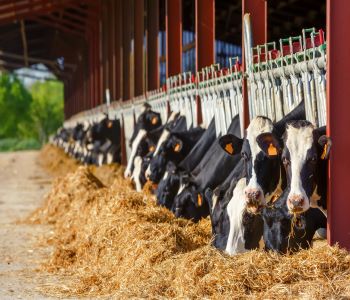Revisiting Feed Bunk Management Norms
Mar 02, 2020

We’ve recognized the key components of successful feed bunk management for so long that we sometimes now take the current recommendations for granted. But, what does the research tell us about what cows actually prefer in their feeding environment? And, could we benefit from a fresh look at some of our feed bunk management norms?
Competition for feed. Are 24 inches of bunk space per cow - the industry standard - sufficient from the cow’s perspective? Researchers at the University of British Columbia addressed this question by providing subordinate cows with a choice: They could choose to eat a low palatability feed alone or they could choose a high palatability feed that came with a dominant cow located either 12, 18, 24, or 30 inches away. When feeding space was highly restrictive (i.e., 12 or 18 inches) most subordinate cows chose to eat the low palatability feed alone. But, even with 24 or 30 inches of feed space about 40% of subordinate cows still chose to eat alone. This research tells us that some cows will settle for less desirable feed to avoid competition - even when bunk space exceeds the current industry standard!
Feeding frequency. Delivery of fresh feed stimulates feeding behavior more than return from the parlor or feed push up. University of Guelph scientists found a benefit of twice over once daily feeding with dry matter intake increasing 3 lb/day while milk yield increased by 4.4 lb/day. With 2x feeding of a TMR, more feed was available throughout the day and there was less feed sorting. The positive response to greater feeding frequency is often more noticeable during heat stress conditions (which will be here before you know it).
However, some research indicates that the positive response to greater feed delivery may diminish at high frequencies, such as 4 or 5 times per day. In these cases, greater feeding frequency enhances eating time but also reduces resting time substantially. Enhancements in feeding time should never be at the expense of time spent resting!
Feed push-up. Effective feed push-up strategy is critical for ensuring that feed is within easy reach of the cow and is a function of the number of times per day and when the feed push-up occurs. A study conducted at the University of Arizona evaluated the effect of feed push-up each half-hour for the first two hours after feed delivery versus only once per hour. In that study, greater frequency of feed push-up during the two hours after feed delivery resulted in more milk and improved efficiency with no impact on stall resting time. The number of times that feed is pushed up throughout the day is important, but this research highlights the critical importance of timing of feed push-up. When deciding a feed push-up strategy, we need to focus on ensuring that feed is easily within reach of the cow during the highly competitive two hours following feed delivery.
Feed refusals and availability. For competitive feeding situations, each 2%-unit increase in feed refusals is associated with a 1.3% increase in sorting. Likewise, milk/DMI decreases by 3% for each 1% increase in sorting. On farm experience suggests that a refusal target of approximately 3% works well for lactation pens, but fresh pens should be closer to 6-7% to ensure that feed availability is never limiting. Be careful that a 2-3% feed refusal target does not result in feed restriction on your farm – look at the bunks as refusals are scraped out.
How long can the feed bunk be empty? The cow’s motivation to eat increases markedly after only 3 hours without feed. In addition, when feed access time is restricted overnight, feed intake is reduced by 3.5 lb/day coinciding with twice as many displacements at feeding – social turmoil at the feed bunk is never a good thing!
As new information is published we need to continually re-assess our feed bunk management recommendations. If we ask the cow for her opinion, using well designed studies and field observations, we will design better feeding environments.
Rick Grant | Miner Agricultural Research Institute President

Competition for feed. Are 24 inches of bunk space per cow - the industry standard - sufficient from the cow’s perspective? Researchers at the University of British Columbia addressed this question by providing subordinate cows with a choice: They could choose to eat a low palatability feed alone or they could choose a high palatability feed that came with a dominant cow located either 12, 18, 24, or 30 inches away. When feeding space was highly restrictive (i.e., 12 or 18 inches) most subordinate cows chose to eat the low palatability feed alone. But, even with 24 or 30 inches of feed space about 40% of subordinate cows still chose to eat alone. This research tells us that some cows will settle for less desirable feed to avoid competition - even when bunk space exceeds the current industry standard!
Feeding frequency. Delivery of fresh feed stimulates feeding behavior more than return from the parlor or feed push up. University of Guelph scientists found a benefit of twice over once daily feeding with dry matter intake increasing 3 lb/day while milk yield increased by 4.4 lb/day. With 2x feeding of a TMR, more feed was available throughout the day and there was less feed sorting. The positive response to greater feeding frequency is often more noticeable during heat stress conditions (which will be here before you know it).
However, some research indicates that the positive response to greater feed delivery may diminish at high frequencies, such as 4 or 5 times per day. In these cases, greater feeding frequency enhances eating time but also reduces resting time substantially. Enhancements in feeding time should never be at the expense of time spent resting!
Feed push-up. Effective feed push-up strategy is critical for ensuring that feed is within easy reach of the cow and is a function of the number of times per day and when the feed push-up occurs. A study conducted at the University of Arizona evaluated the effect of feed push-up each half-hour for the first two hours after feed delivery versus only once per hour. In that study, greater frequency of feed push-up during the two hours after feed delivery resulted in more milk and improved efficiency with no impact on stall resting time. The number of times that feed is pushed up throughout the day is important, but this research highlights the critical importance of timing of feed push-up. When deciding a feed push-up strategy, we need to focus on ensuring that feed is easily within reach of the cow during the highly competitive two hours following feed delivery.
Feed refusals and availability. For competitive feeding situations, each 2%-unit increase in feed refusals is associated with a 1.3% increase in sorting. Likewise, milk/DMI decreases by 3% for each 1% increase in sorting. On farm experience suggests that a refusal target of approximately 3% works well for lactation pens, but fresh pens should be closer to 6-7% to ensure that feed availability is never limiting. Be careful that a 2-3% feed refusal target does not result in feed restriction on your farm – look at the bunks as refusals are scraped out.
How long can the feed bunk be empty? The cow’s motivation to eat increases markedly after only 3 hours without feed. In addition, when feed access time is restricted overnight, feed intake is reduced by 3.5 lb/day coinciding with twice as many displacements at feeding – social turmoil at the feed bunk is never a good thing!
As new information is published we need to continually re-assess our feed bunk management recommendations. If we ask the cow for her opinion, using well designed studies and field observations, we will design better feeding environments.
Rick Grant | Miner Agricultural Research Institute President
